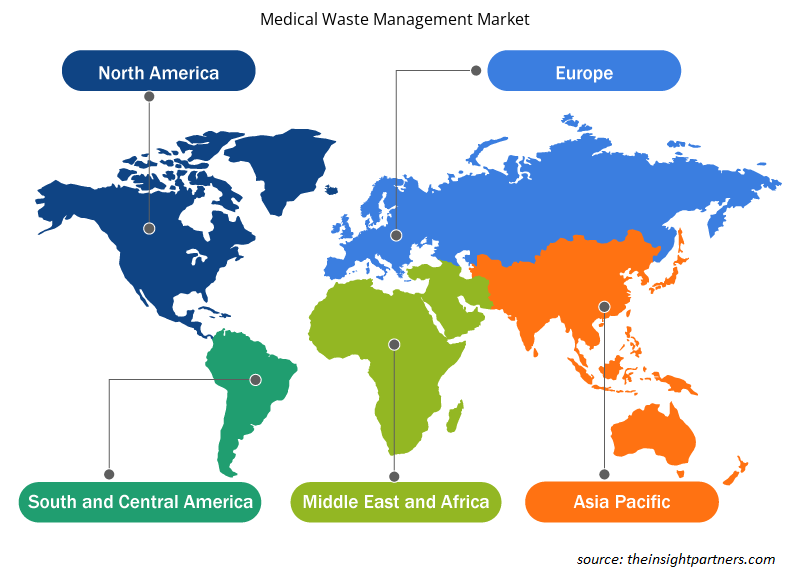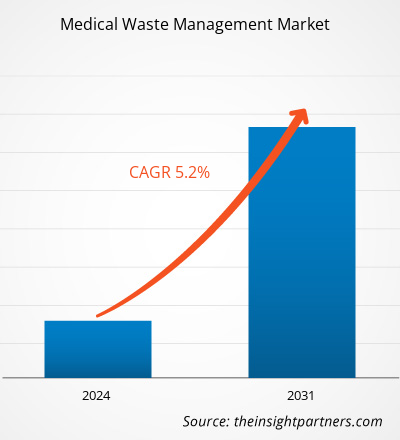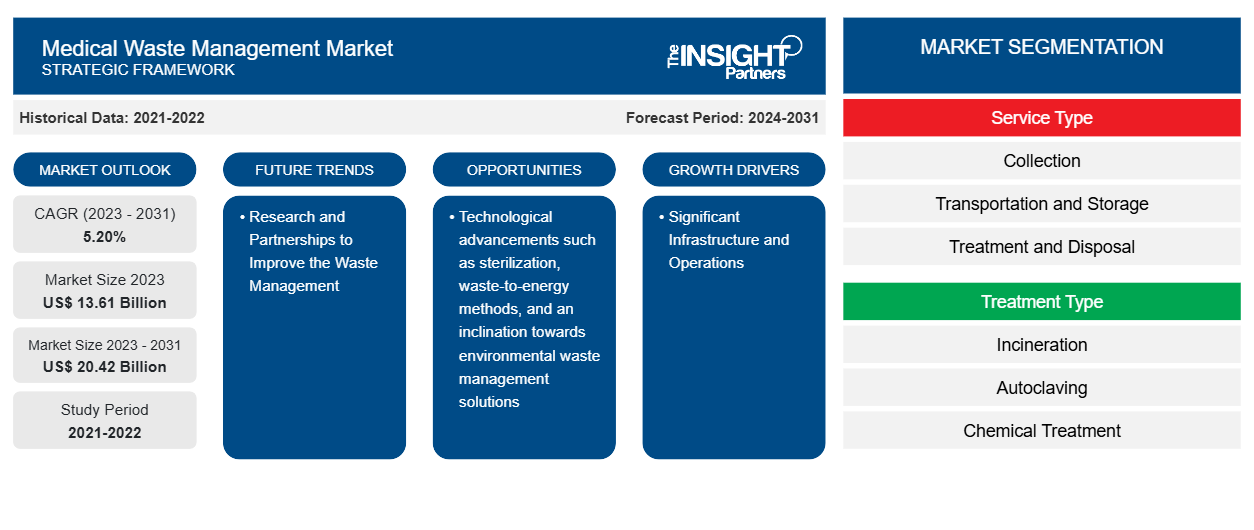2023 年医疗废物管理市场价值为 136.1 亿美元,预计到 2031 年将达到 204.2 亿美元。预计 2023-2031 年该市场的复合年增长率为 5.20%。灭菌、废物转化为能源的方法等技术进步以及对环境废物管理解决方案的倾向可能仍将是医疗废物管理市场的主要趋势。
医疗废物管理市场分析
医疗设施中心和生命科学加工企业产生的废物称为医疗废物。医疗保健机构产生的医疗废物包括脏敷料、血液、化学品、身体部位、医疗设备和诊断样本等。医疗废物管理控制这些医疗废物的产生、处理、处理和处置。医疗废物数量的增加、管理医疗废物的举措以及全球患者入院人数的增加都促进了全球医疗废物管理市场的增长。
医疗废物管理市场概览
医疗废物管理是医疗保健的重要组成部分。如果医疗废物管理不当,医护人员、废物处理人员和普通公众都面临感染、有害影响、伤害和环境污染的风险。2014 年,世界卫生组织制定了《医疗活动废物安全管理指南》,这是第一份全球性综合指导文件。指南涵盖了法律框架、规划问题、回收和废物最小化、处理、储存、运输、处理和处置方案以及培训等方面。
定制此报告以满足您的需求
您可以免费定制任何报告,包括本报告的部分内容、国家级分析、Excel 数据包,以及为初创企业和大学提供优惠和折扣
-
获取此报告的关键市场趋势。这个免费样品将包括数据分析,从市场趋势到估计和预测。
医疗废物管理市场驱动因素和机遇
重大基础设施和运营有利于市场
高度重视预测和管理供应需求以增强基础设施的更重要方法可能会促进市场增长。临床工作人员对塑料废物类型以及回收和分类程序的教育计划有助于最大限度地遵守指导方针,有助于改善运营。在当地机构网络内建立管道以分发未使用的医疗用品,以减少浪费和财务支出。这反过来又推动了市场的扩张。例如,2022 年 7 月,联合国发展计划署 (UNDP) 驻伊拉克办事处和卫生部 (MoH) 签署了一项价值 2500 万美元的协议,以改善该国的医疗废物管理。
研究与合作——医疗废物管理市场的机遇
增加对安全可回收的医用塑料设计、经济地生产生物塑料和其他一次性塑料替代品的资金投入,以及对医疗用品再加工和创造更多增值产品的区域基础设施的投资,同时防止整个系统出现短缺,可能会为市场增长创造巨大的机会。例如,2021 年 4 月,领先的中型市场私募股权公司 Aurora Capital Partners 宣布已从 Summer Street Capital Partners 收购了 Curtis Bay Medical Waste Services。Curtis Bay Medical Waste Services 是医疗废物收集、处理和处置服务的领导者。
医疗废物管理市场报告细分分析
对医疗废物管理市场分析做出贡献的关键部分是服务类型、治疗类型、治疗地点和地理位置。
- 根据服务类型,医疗废物管理市场分为收集、运输和储存、处理和处置、回收。处理和处置部分在 2023 年占据了更大的市场份额。
- 根据处理类型,市场分为焚烧、高压灭菌、化学处理等。焚烧部分在 2023 年占据了更大的市场份额。
- 根据处理地点,医疗废物管理市场分为场外和场内。场外部分在 2023 年占据了相当大的市场份额
医疗废物管理市场份额(按地区)分析
医疗废物管理市场报告的地理范围分为五个区域:北美、亚太、欧洲、中东和非洲、南美/南美和中美。
北美主导着医疗废物管理市场。在北美,美国是 2023 年最大的医疗废物管理市场。在有机和无机战略方面投入大量资金的关键参与者预计将推动该地区的市场增长。例如,2024 年 1 月,纽约州主要医疗保健提供商 Northwell Health 和致力于消除目前不可持续的受管制医疗废物处理做法的尖端清洁技术公司 Envetec Sustainable Technologies Limited 宣布安装 GENERATIONS。这项创新技术旨在安全有效地现场处理受控医疗废物,例如一次性塑料实验室器皿、玻璃、个人防护设备和锐器容器。
医疗废物管理市场区域洞察
Insight Partners 的分析师已详细解释了预测期内影响医疗废物管理市场的区域趋势和因素。本节还讨论了北美、欧洲、亚太地区、中东和非洲以及南美和中美洲的医疗废物管理市场细分和地理位置。

- 获取医疗废物管理市场的区域具体数据
医疗废物管理市场报告范围
| 报告属性 | 细节 |
|---|---|
| 2023 年的市场规模 | 136.1亿美元 |
| 2031 年市场规模 | 204.2亿美元 |
| 全球复合年增长率(2023 - 2031) | 5.20% |
| 史料 | 2021-2022 |
| 预测期 | 2024-2031 |
| 涵盖的领域 |
按服务类型
|
| 覆盖地区和国家 |
北美
|
| 市场领导者和主要公司简介 |
|
医疗废物管理市场参与者密度:了解其对业务动态的影响
医疗废物管理市场正在快速增长,这得益于终端用户需求的不断增长,而这些需求又源于消费者偏好的不断变化、技术进步以及对产品优势的认识不断提高等因素。随着需求的增加,企业正在扩大其产品范围,进行创新以满足消费者的需求,并利用新兴趋势,从而进一步推动市场增长。
市场参与者密度是指在特定市场或行业内运营的企业或公司的分布情况。它表明相对于给定市场空间的规模或总市场价值,有多少竞争对手(市场参与者)存在于该市场空间中。
在医疗废物管理市场运营的主要公司有:
- Medasend Biomedical, Inc.
- 邦德科技公司
- 夏普合规公司
- 威立雅
- 清洁港口公司
- 丹尼尔斯夏普智能公司
免责声明:上面列出的公司没有按照任何特定顺序排列。

- 了解医疗废物管理市场顶级关键参与者概况
医疗废物管理市场新闻和最新发展
医疗废物管理市场通过收集一手和二手研究后的定性和定量数据进行评估,其中包括重要的公司出版物、协会数据和数据库。以下是医疗废物管理市场的发展和策略列表:
- 全球废物解决方案提供商 Brightmark 和总部位于威斯康星州的医疗保健产品制造商 Jamar Health Products 今天宣布建立战略合作伙伴关系,以回收塑料医疗废物。Brightmark 提供了一种可持续的循环解决方案,用于回收和将 Jamar 专有的塑料 PATRAN 滑动片转化为低碳燃料和循环塑料的基石。(来源:Brightmark 公司名称,通讯,2022 年)
医疗废物管理市场报告范围和交付成果
“医疗废物管理市场规模和预测(2021-2030 年)”报告对以下领域进行了详细的市场分析:
- 范围内所有主要细分市场的全球、区域和国家层面的市场规模和预测
- 市场动态,如驱动因素、限制因素和关键机遇
- 未来主要趋势
- 详细的 PEST/波特五力分析和 SWOT 分析
- 全球和区域市场分析涵盖关键市场趋势、主要参与者、法规和最新市场发展
- 行业格局和竞争分析,涵盖市场集中度、热点图分析、知名参与者和最新发展
- 详细的公司简介
- 历史分析(2 年)、基准年、预测(7 年)及复合年增长率
- PEST和SWOT分析
- 市场规模、价值/数量 - 全球、区域、国家
- 行业和竞争格局
- Excel 数据集
近期报告
相关报告
客户评价
购买理由
- 明智的决策
- 了解市场动态
- 竞争分析
- 客户洞察
- 市场预测
- 风险规避
- 战略规划
- 投资论证
- 识别新兴市场
- 优化营销策略
- 提升运营效率
- 顺应监管趋势























 获取免费样品 - 医疗废物管理市场
获取免费样品 - 医疗废物管理市场